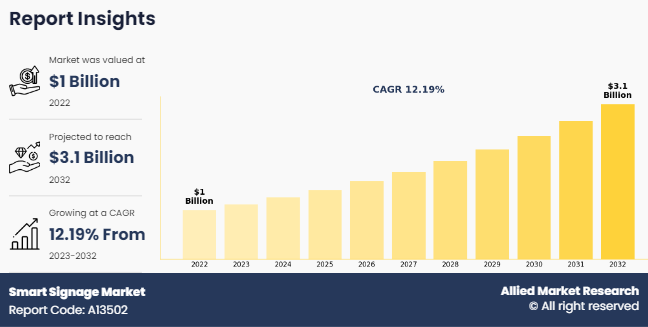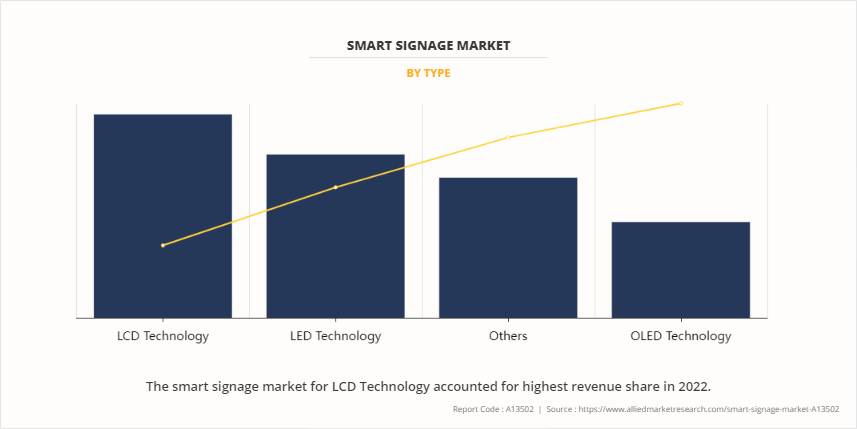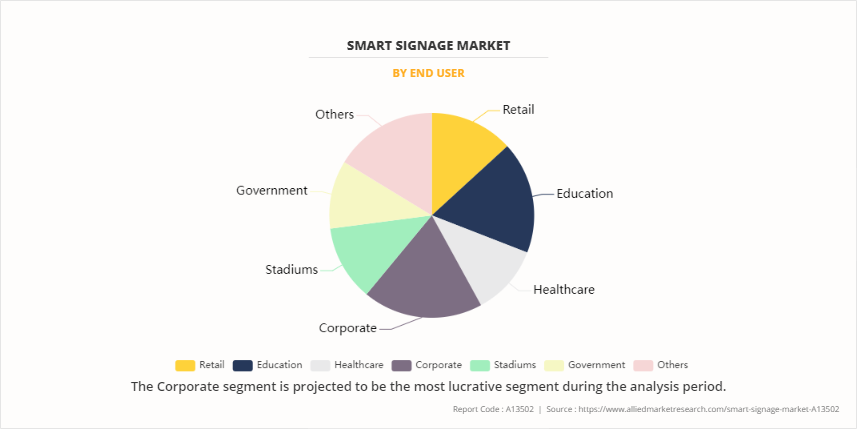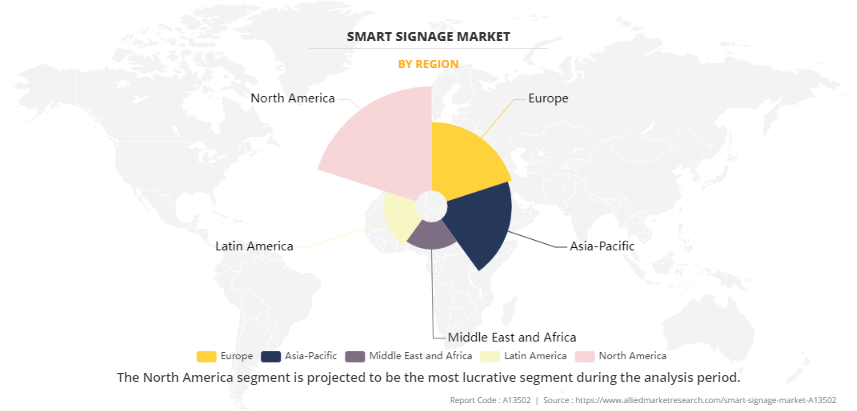Smart Signage Market Research, 2032
The Global Smart Signage Market was valued at $1 billion in 2022, and is projected to reach $3.1 billion by 2032, growing at a CAGR of 12.19% from 2023 to 2032.
The smart signage market is expected to witness notable growth, owing to proliferation of 4K displays that offer high resolution and clarity. Furthermore, the integration of smart signage with IoT technology is expected to provide lucrative opportunities for the growth of the market during the forecast period. On the contrary, high investment cost concerns limit the growth of the smart signage market.

Smart signage refers to a network of interconnected digital displays that provide targeted information, entertainment, merchandising, and advertising. These displays can be managed centrally, and their messaging can be adjusted to suit specific audiences or time frames. Smart signage includes several types of displays such as large-format displays, interactive flat panels, video walls, kiosk displays, outdoor displays, and specialty displays.
Key Takeaways of Smart Signage Market Report
- On the basis of type, the other segment dominated the smart signage market size in terms of revenue in 2022. However, the OLED segment is anticipated to grow at the fastest CAGR during the forecast period.
- On the basis of end user, the corporate segment dominated the smart signage market size in terms of revenue in 2022. However, the Retail segment is anticipated to grow at the fastest CAGR during the forecast period.
- Region-wise, North America generated the largest revenue in 2022. However, Asia-Pacific is anticipated to grow at the highest CAGR during the forecast period.
Segment Overview
The smart signage market is segmented into type, end user, and region.

On the basis of type, the market is divided into OLED technology, LCD technology, LED technology, and others. In 2022, the LCD Technology dominated the market in terms of revenue. Moreover, the LED Technology segment is projected to have the highest CAGR during the forecast period.

On the basis of end user, the smart signage market insights is classified into retail, education, healthcare, corporate, stadiums, government, and others. In 2022, the corporate segment dominated the market in terms of revenue. However, the Healthcare segment is expected to manifest the highest CAGR during the forecast period.

On the basis of region, it is analyzed across North America (the U.S., Canada, and Mexico), Europe (the UK, Germany, France, Italy, and the rest of Europe), Asia-Pacific (China, Japan, India, South Korea, and rest of Asia-Pacific), Latin America (Brazil, Argentina, and rest of Latin America), and Middle East and Africa (Saudi Arabia, Africa, and rest of Middle East and Africa).
Asia-Pacific, specifically China, remains a significant participant in the smart signage market with a CAGR of 14.13% due to high investments in the consumer electronics sector, which is driving the growth of the smart signage industry in Asia-Pacific region.
Competitive Analysis
The smart signage market share by company and profiles provided in this report include, BenQ, Samsung, LG Electronics, VESTEL, ASUS Global, Tripleplay, NEC, Panasonic, Advantech, and Sony. Product launch and acquisition business strategies were adopted by the major market players in 2022. For instance, on January 16, 2024, Samsung launched Visual eXperience Transformation (VXT) platform, a cloud-native content management solution (CMS) combining content and remote signage management on one secure platform.
Market Dynamics
Rise in Demand for Digital Advertising
The rise in demand for digital advertising plays a significant role in propelling the growth of the smart signage growth projections. Businesses increasingly recognize the effectiveness of digital signage in capturing audience attention, delivering dynamic content, and engaging customers in ways traditional static signage cannot. Digital signage offers the flexibility to display multimedia content, including videos, animations, and interactive elements, enabling more impactful and memorable brand messaging. Moreover, digital signage allows for real-time content updates and targeted advertising based on factors such as time of day, location, and audience demographics, enhancing relevance and effectiveness. This capability aligns with the evolving preferences of consumers for personalized and interactive experiences, driving businesses to invest in digital signage solutions to stay competitive in an increasingly digital and visually driven marketplace. Therefore, the demand for smart signage continues to grow across various industries, from retail and hospitality to transportation and corporate environments.
Integration of smart signage with IoT ecosystems
The integration of smart signage with IoT ecosystems represents a significant opportunity to enhance their functionality and value proposition. By interfacing with IoT devices and sensors, smart signage can capture real-time data on environmental conditions, customer behavior, and operational metrics. This integration enables dynamic content management based on contextual factors such as weather conditions, foot traffic patterns, and inventory levels. Furthermore, smart signage can facilitate interactive experiences by interacting with IoT-enabled devices such as smartphones or wearables to deliver personalized content and enable transactions. This collaboration between smart signage and IoT ecosystems not only improves the effectiveness of digital displays but also expands their applications across various sectors, including smart cities, transportation, retail, and hospitality. This fosters innovation and creates new avenues for engaging customers and optimizing operation.
High initial investment
The high initial investment required for deploying smart signage solutions includes various costs, including purchasing hardware components such as displays, media players, and sensors, as well as investing in software development, content creation, installation, and ongoing maintenance. These expenses can be particularly daunting for small and medium-sized businesses with limited budgets, leading to hesitation in adopting smart signage technology. In addition, the need for specialized expertise to design, implement, and manage smart signage systems further contributes to the overall cost. Furthermore, the return on investment (ROI) for smart signage projects may not be immediately apparent, making it challenging for stakeholders to justify the expenditure. Therefore, the high initial investment acts as a significant restraint, limiting the widespread adoption of smart signage across various industries and sectors.
Recent Developments in Smart Signage Industry
- On January 16, 2024, Samsung launched Visual eXperience Transformation (VXT) platform, a cloud-native content management solution (CMS) combining content and remote signage management on one secure platform.
Key Benefits For Stakeholders
- This report provides a quantitative analysis of the market segments, current trends, estimations, and dynamics of the smart signage market analysis from 2022 to 2032 to identify the prevailing smart signage market opportunity.
- The market research is offered along with information related to key drivers, restraints, and opportunities.
- Porter's five forces analysis highlights the potency of buyers and suppliers to enable stakeholders make profit-oriented business decisions and strengthen their supplier-buyer network.
- In-depth analysis of the smart signage market segmentation assists to determine the prevailing market opportunities.
- Major Smart Signage Market Size by Country in each region are mapped according to their revenue contribution to the global market.
- Smart signage companies positioning facilitates benchmarking and provides a clear understanding of the present position of the smart signage companies.
- The report includes the analysis of the regional as well as global smart signage market trends, Smart Led Signage, Smart Signage Platform, key players, Smart Digital Signage segments, application areas, Smart Digital Signage market, and Smart Signage Market Statistics.
Smart Signage Market Report Highlights
| Aspects | Details |
| Market Size By 2032 | USD 3.1 billion |
| Growth Rate | CAGR of 12.19% |
| Forecast period | 2022 - 2032 |
| Report Pages | 250 |
| By Type |
|
| By End User |
|
| By Region |
|
| Key Market Players | Samsung, LG Electronics, VESTEL, Asus, NEC Corporation, Sony Electronics Inc., BenQ, Panasonic, Tripleplay, Advantech Co., Ltd. |
Analyst Review
The global smart signage market holds high potential for the semiconductor industry. The market witnesses increase in demand for smart signage devices, particularly in developing regions, such as China, India, the Saudi Arabia, and South Africa. Companies in this industry have been adopting various innovative techniques to provide customers with advanced and innovative product offerings.
The smart signage market is expected to witness notable growth owing to surge in urbanization and the proliferation of smart city projects. Moreover, the adoption of smart signage in the healthcare sector is expected to provide lucrative opportunities for the growth of the market during the forecast period. On the contrary, high initial investment limits the growth of the smart signage market.
The key players profiled in the report include, BenQ, Samsung, LG Electronics, VESTEL, ASUS Global, Tripleplay, NEC, Panasonic, Advantech, and Sony these key players have adopted strategies such as product portfolio expansion, mergers & acquisitions, agreements, geographical expansion, and collaborations to enhance their market penetration.
Integration of Artificial Intelligence (AI), and Integration with IoT and Data Analytics are the upcoming trends of smart signage market in the world.
Corporate segment is the leading application of the smart signage market.
North America is the largest regional market for smart signage.
In 2022, $1 billion is the estimated industry size of smart signage market.
BenQ, Samsung, LG Electronics, VESTEL, ASUS Global, Tripleplay, NEC, Panasonic, Advantech, and Sony are the top companies to hold the market share in smart signage
Loading Table Of Content...
Loading Research Methodology...



